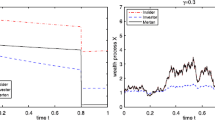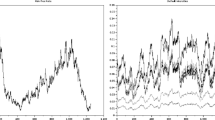Abstract
In this paper, we analyse a market where the risky assets follow defaultable exponential additive processes, with coefficients depending on the default state of the assets. In this market we show that when an investor wants to maximize a utility function which is logarithmic on both his/her consumption and terminal wealth, his/her optimal portfolio strategy consists in keeping proportions of wealth in the risky assets which only depend on time and on the default state of the risky assets, but not on their price or on current wealth level; this generalizes analogous results of Pasin and Vargiolu (Econ Notes 39:65–90, 2010) in non-defaultable markets without intermediate consumption. We then present several examples of market where one, two or several assets can default, with the possibility of both direct and information-induced contagion, obtaining explicit optimal investment strategies in several cases. Finally, we study the growth-optimal portfolio in our framework and show an example with necessary and sufficient conditions for it to be a proper martingale or a strict local martingale.
Similar content being viewed by others
References
Ang A, Bekaert G (2002) International asset allocation with regime shifts. Rev Financ Stud 15:1137–1187
Antonelli F, Ramponi A, Scarlatti S (2013) Option-based risk management of a bond portfolio under regime switching interest rates. Decis Econ Financ 36:47–70
Backhaus J, Frey R (2008) Pricing and hedging of portfolio credit derivatives with interacting default intensities. Int J Theor Appl Financ 11:611–634
Becherer D (2001) The numeraire portfolio for unbounded semimartingales. Financ Stoch 5:327–341
Bellamy N (2001) Wealth optimization in an incomplete market driven by a jump-diffusion process. J Math Econ Spec Issue Arbitr Control Probl Financ 35(3):259–287
Benth F, Schmeck M (2012) Stability of Merton’s portfolio optimization problem for Lévy models. Stochastics 85(5):833–858
Benth FE, Karlsen KH, Reikvam K (2001) Optimal portfolio management rules in a non-Gaussian market with durability and intertemporal substitution. Financ Stoch 5:447–467
Bhanot DHK, Burns N, Williams M (2014) News spillovers from the Greek debt crisis: impact on the Eurozone financial sector. J Bank Financ 38:51–63
Bielecki T, Jang I (2006) Portfolio optimization with a defaultable security. Asia Pac Financ Mark 13:113–127
Bo L, Wang Y, Yang X (2010) An optimal portfolio problem in a defaultable market. Adv Appl Probab 42:689–705
Bühlmann H, Platen E (2003) A discrete time benchmark approach for insurance and finance. Astin Bull 33:153–172
Callegaro G (2013) Optimal consumption problems in discontinuous markets. Optimization 62(11):1575–1602
Callegaro G, Vargiolu T (2009) Optimal portfolio for HARA utility functions in a pure jump multidimensional incomplete market. Int J Risk Assess Manag Spec Issue Meas Manag Financ Risk 11:180–200
Callegaro G, Jeanblanc M, Runggaldier WJ (2012) Portfolio optimization in a defaultable market under incomplete information. Decis Econ Financ 35:91–111
Capponi A, Figueroa-López J (2014) Dynamic portfolio optimization with a defaultable security and regime-switching markets. Math Financ 24(2):207–249
Capponi A, Figueroa-López J, Nisen J (2014) Pricing and semimartingale representations of vulnerable contingent claims in regime-switching markets. Math Financ 24(2):250–288
Christensen MM, Larsen K (2007) No arbitrage and the growth optimal portfolio. Stoch Anal Appl 25:255–280
Cont R, Tankov P (2004) Financial modelling with jump processes. Chapman & Hall/CRC financial mathematics series. Chapman & Hall/CRC, Boca Raton
Cousin A, Jeanblanc M, Laurent J-P (2011) Hedging CDO, tranches in a Markovian environment. In: Paris-Princeton lectures on mathematical finance 2010. Lecture notes in mathematics, vol 2003. Springer, Berlin, pp 1–61
Cvitanić J, Karatzas I (1992) Convex duality in constrained portfolio optimization. Ann Appl Probab 2:767–818
Dai KJSQ, Yang W (2007) Regime shifts in a dynamic term structure model of U.S. treasury bond yields. Rev Financ Stud 20:1669–1706
Dumontaux N, Pop A (2012) Contagion effects in the aftermath of Lehman’s collapse: measuring the collateral damage. LEMNA Working Paper, vol 27, pp 1–45
Fleming WH, Soner HM (2006) Controlled Markov processes and viscosity solutions, 2nd edn. Stochastic modelling and applied probability, vol 25. Springer, New York
Fontana C, Runggaldier W (2013) Diffusion-based models for financial markets without martingale measures. In: Biagini F, Richter A, Schlesinger H (eds) Risk measures and attitudes. EAA series, Springer, pp 45–81
Framstad NC, Øksendal B, Sulem A (2001) Optimal consumption and portfolio in a jump diffusion market with proportional transaction costs. J Math Econ Spec Issue Arbitr Control Probl Financ 35(3):233–257
Gentile M, Giordano L (2012) Financial contagion during Lehman default and sovereign debt crisis. Quaderni di Finanza CONSOB 72:3–46
Giesecke SSK, Longstaff F, Strebulaev I (2011) Corporate bond default risk: a 150-year perspective. J Financ Econ 102:233–250
Jeanblanc-Picqué M, Pontier M (1990) Optimal portfolio for a small investor in a market model with discontinuous prices. Appl Math Optim 22:287–310
Kallsen J (2000) Optimal portfolios for exponential Lévy processes. Math Methods Oper Res 51:357–374
Kazi IR, Salloy S (2013) Contagion effect due to Lehman Brothers’ bankruptcy and the global financial crisis—from the perspective of the credit default swaps’ G14 dealers. Working Paper Université Paris Ouest, 06, pp 1–49
Korn R, Oertel F, Schäl M (2003) The numeraire portfolio in financial markets modeled by a multi-dimensional jump diffusion process. Decis Econ Financ 26:153–166
Kramkov D, Schachermayer W (1999) The asymptotic elasticity of utility functions and optimal investment in incomplete markets. Ann Appl Probab 9:904–950
Liu J, Longstaff F, Pan J (2003) Dynamic asset allocation with event risk. J Financ 58:231–259
Øksendal B, Sulem A (2005) Applied stochastic control of jump diffusions. Springer, Berlin
Pasin L, Vargiolu T (2010) Optimal portfolio for HARA utility functions where risky assets are exponential additive processes. Econ Notes 39:65–90
Platen E (2006) A benchmark approach to finance. Math Financ 16:131–151
Protter PE (2004) Stochastic integration and differential equations. In: Stochastic modelling and applied probability. Applications of mathematics (New York), vol. 21, 2nd edn. Springer, Berlin
Valdez A, Vargiolu T (2013) Optimal portfolio in a regime-switching model. In: Seminar on stochastic analysis, random fields and applications VI—Centro Stefano Franscini-Ascona. Progress in probability, vol 67. Springer, Berlin, pp 435–449
Acknowledgments
A significant portion of the research reported in this paper was done while the first author was a PhD student in the Department of Mathematics at the University of Padova. This work was partially supported by the grant CPDA138873-2013 of the University of Padova ’Stochastic models with spatial structure and applications to new challenges in Mathematical Finance, with a focus on the post-2008 financial crisis environment and on energy markets’. The authors would like to thank Giorgia Callegaro, Wolfgang Runggaldier and two anonymous referees for constructive comments which contributed to improve the quality of this manuscript.
Author information
Authors and Affiliations
Corresponding author
Appendix: Proof of Theorem 5.4
Appendix: Proof of Theorem 5.4
We first need to introduce the following notation.
Definition 8.1
Given \(d\in \{0,1\}^n\), we call the length of \(d\) the positive integer defined as
Moreover we establish on \(\{0,1\}^n\) the following (partial) order relation:
Note that given \(D_t=d\) for a certain \(t\le 0\), the states \(d'<d\) are the only states accessible for \(D\) after the time \(t\).
Roughly speaking, the length of \(d\) is equal to the number of risky asset that are still alive. In particular, when every firm has already defaulted we have \(l(d)=0\), whereas when every firm did not we have \(l(d)=n\). We also explicitly observe that
Hence by (5.4), given a state \(d\in \{0,1\}^n\), \(A^h J(t,x,d)\) depends only on the states \(d'\le d\), i.e. the states whose alive assets are a subset of the alive ones in \(d\); in other words, \(A^{h,c} J(t,x,d)\) does not depend on the assets whose entities have already defaulted.
We also need the following
Lemma 8.2
Consider the function
with \(A,B\ge 0,A+B>0\). Then, for any \(t\in [0,T]\) and \(v>0\) we have
where \({\bar{c}}\) is defined as in (5.16). Moreover,
if \(\delta >0,\) whereas
if \(\delta =0\).
Proof
We only prove the case \(\delta >0\). For any \(t\in [0,T],v>0\) we have
if and only if \(c={\bar{c}}(t)v\). Thus, \({\bar{c}}(t)v\) is the only stationary point for \(\psi (t,v,\cdot )\), and since \(\lim _{c\rightarrow 0}\psi (t,v,c)=\lim _{c\rightarrow \infty }\psi (t,v,c)=-\infty \), we obtain (8.2). Eventually, (8.3) follows from a direct computation. \(\square \)
We now prove Theorem 5.4.
Proof of Theorem 5.4
We only prove the theorem for \(\delta >0\), as the case \(\delta =0\) is totally analogous.
Part (a). By induction on \(k=l(d)\). We start proving the statement when \(k=0\). In this case we clearly have \(d={\mathbf {1}}:=(1,\ldots ,1)\), i.e. all the entities have defaulted. If we search for a solution of the kind \(K(t,v,d)\) as in (5.13), we clearly obtain
so that the HJB equation becomes
with \(\psi (t,v,c)\) as in (8.1). Thus by Lemma 8.2 we have
Therefore, we define \(\Phi ^{{\mathbf {1}}}\) as the unique solution of (8.6) provided with the terminal condition \(\Phi ^{{\mathbf {1}}}(T)=0\), so that \(K(t,v,{\mathbf {1}})\) solves Eq. (5.3) with the terminal condition (5.7).
We now assume the statement to be true for any \(d'\in \{0,1\}^n\) such that \(l(d')\le k-1\) and prove it to be true for any \(d\) such that \(l(d)=k\). We set
where \(\Phi ^{d}\) is a \(C^1\) deterministic function such that \(\Phi ^{d}(T)=0\). Then we have
Therefore we obtain
[by (5.6)]
where
[by (8.7)]
with
and where
(by induction hypothesis)
[by (5.6)]
where \(\varphi ^{d}\) is the continuous deterministic function
with
Thus we obtain
with \(F^d\) as in (5.12), and the HJB equation becomes
with \(\psi (t,v,c)\) as in (8.1). Let us observe that \(\arg \max _{h\in H}F^{d}(t,h)\) is not empty for any \(t\in [0,T]\) because \(H\) is a compact subset of \({\mathbb {R}}^n\) and \(F^{d}\) is continuous, and thus
with \(F^d\) as in (8.1). Therefore, plugging (8.11)–(8.2) into (8.10) we get
[by (8.3)]
Furthermore, note that \(\varphi ^{d}(t)\) and \(\nu ^d_t\left( \Theta ^{d}\right) \) are continuous in \(t\) by Assumption 3.5. Thus, setting \(\Phi ^{d}(\cdot )\) as the unique solution of the ODE (8.12) with terminal condition \(\Phi ^{d}(T)=0\), we have that \(K(t,v,d)\) solves Eq. (5.3) with terminal condition (5.7), and Part (a) is proved.
Part (b). To prove \(K\in {\mathcal D}\) it is sufficient to prove that for any \(\bar{t}\in [0,T]\) and \(({\mathfrak {h}},{\mathfrak {c}})\in {\mathcal A}[\bar{t},T]\),
is a martingale. Now, by applying the Itô formula, we obtain
where
and where we have set \(a(t):=A +\frac{B}{\delta }\left( 1- \mathrm{e}^{-\delta (T-t)} \right) \). Therefore, to prove the theorem it is sufficient to check that \(M_t\) is a martingale. Since
the continuous part is a martingale. We observe now that since \({\mathfrak {h}}\) takes values in the compact set \(H\subset \hbox {int}(\cap _{t\in [\bar{t},T]}H_t)\), there exists a constant \(\delta >0\) such that \(1+\langle {\mathfrak {h}}_t,x \rangle \ge \delta \) \(\nu ^d({\mathrm {d}}x)\)-a.s. for any \(d\in \{0,1\}^n\), \(t\in [\bar{t},T]\). Thus, the function \(x\rightarrow \log {(1+\langle {\mathfrak {h}}_t,x \rangle )}\) is bounded from below and with linear growth, and so there is a constant \(C>0\) such that
for any \(d\in \{0,1\}^n\), \(t\in [\bar{t},T]\). According now to the notation used in the proof of part (a), we define
and finally, to verify the pure jump stochastic integral to be a martingale, we only need to check that for any \(d\in \{0,1\}^n\)
(by the triangular inequality)
[by (8.14) and Assumption 3.3]
Part (c). By (8.9), (8.11) and Lemma 8.2 we have
for any \(t\in [0,T]\) and \(d\in \{0,1\}^n\). Therefore, the process \((\bar{{\mathfrak {h}}}_t,\bar{{\mathfrak {c}}}_t)\) defined in (5.14) satisfies (5.9) and the statement follows by Theorem 5.2. \(\square \)
Rights and permissions
About this article
Cite this article
Pagliarani, S., Vargiolu, T. Portfolio optimization in a defaultable Lévy-driven market model. OR Spectrum 37, 617–654 (2015). https://doi.org/10.1007/s00291-014-0374-7
Published:
Issue Date:
DOI: https://doi.org/10.1007/s00291-014-0374-7




